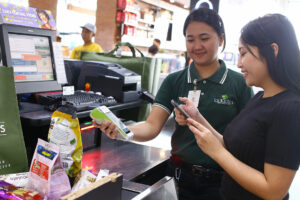PHL companies expect growth in cashless payments to continue

By Arjay L. Balinbin, Senior Reporter
PAYMENT SOLUTION PROVIDERS said enterprises in the Philippines are increasingly accepting cashless payments, and this trend is expected to continue.
“More enterprises are now accepting cashless payments. For example, the number of our registered merchant touchpoints in end-September 2022 tripled year on year, and many of these are micro, small and medium enterprises (MSMEs),” Maya Group President and Maya Bank Co-Founder Shailesh Baidwan told BusinessWorld in an e-mail interview last week.
During the pandemic, Maya rolled out a digital transformation solution for enterprises, allowing them to accept digital payments as they earn additional income from other digital services such as remittance, cash-in and out, bills payment, and load transactions.
“At the height of the pandemic, going cashless was out of necessity. Today, more Filipinos are opting to use digital payments,” Mr. Baidwan said.
According to the Visa Consumer Payments Attitude Study 2022, nearly four of every five Filipino consumers (78%) plan to use digital payments more often, with three in four (79%) believing it is safer.
“This growing demand for digital payments continues — there’s no turning back from this rising tide,” Mr. Baidwan said, adding that everyday transactions such as airtime load, bill payment, money transfers and shopping are driving growth.
He noted that more digital banking services, such as savings and credit, are driving digital payment transactions.
“We’re seeing this in our Maya app — customers who have saving accounts, for example, are very active in using their wallets for everyday payments because the experience is conveniently seamless and intuitive,” Mr. Baidwan added.
GrabPay, also a payment solution provider in the Philippines, said it continued to see growth in cashless transactions despite the full reopening of the economy.
This is “driven by both online and offline merchants,” GrabPay said in a statement to BusinessWorld last week.
“We are seeing more retailers accepting payments via e-wallets. This is most particularly evident on offline merchants with the implementation of PH QR,” it added, referring to the national quick response (QR) code standard, which the Bangko Sentral ng Pilipinas and the Philippine Payments Management, Inc. launched in 2019.
GCash President and Chief Executive Officer Martha M. Sazon said the company saw higher user engagement “now that things have started to normalize.”
This is “further proof that GCash has become embedded in the everyday lives of Filipinos,” she said in an e-mailed statement.
GCash had 66 million users as of the second quarter of the year, while Maya, which rebranded from PayMaya in April, had 50 million registered users across its consumer platforms.
Mr. Baidwan said Maya has powered “over 700,000 registered merchant touchpoints with QR payments.”
According to GCash, it expanded its cash-in and cash-out outlets to 339,000 in the first half of the year.
“It just goes to show that the Filipinos’ shift to a more digital lifestyle is not limited to those during lockdowns. We continue to see the adoption increasing, and even the everyday use and use case diversity are growing. I think the adoption is here to stay and we’re not seeing it plateauing in the near future,” Ms. Sazon said.
According to London-based data analytics and consulting company GlobalData Plc, food and drink accounted for the largest share of the total e-commerce transaction value last year due to the popularity of online grocery sales and on-demand food delivery services amid the public health crisis.
“This has somehow softened during the onset of the easing of lockdown restrictions, but it is picking up back again especially during the holidays,” GrabPay said.
Maya’s Mr. Baidwan said people are now enjoying more mobility amid the “early post-pandemic period. The return to normalcy translates to an upward trend for digital transactions in the travel, entertainment, food, and retail sectors, he added.
“The share of offline payment transactions for food and groceries posted double-digit year-on-year growths, even as consumers continued to order and shop online. Entertainment and travel-related transactions posted the highest growth in terms of volume, based on data from 2022. Travel-related transactions in May this year grew 10X year on year, while entertainment grew by 9X for the same period,” Mr. Baidwan said.




